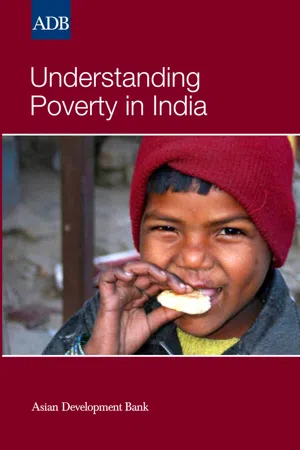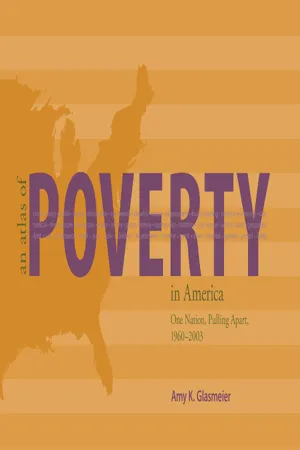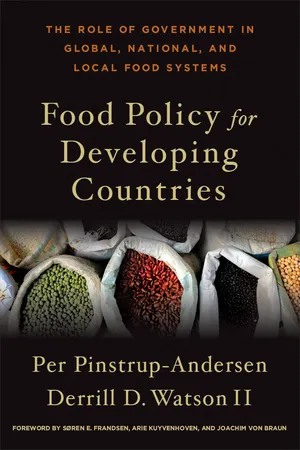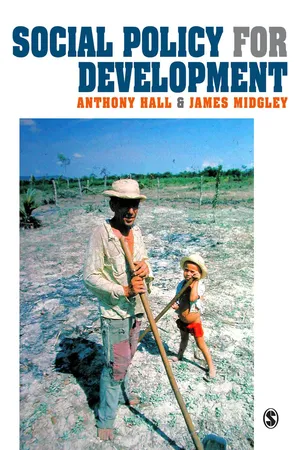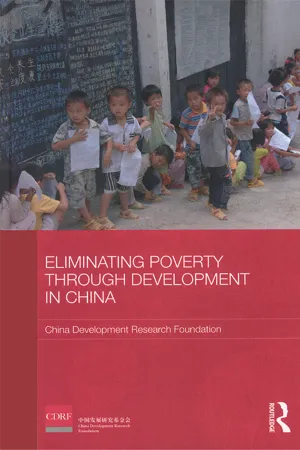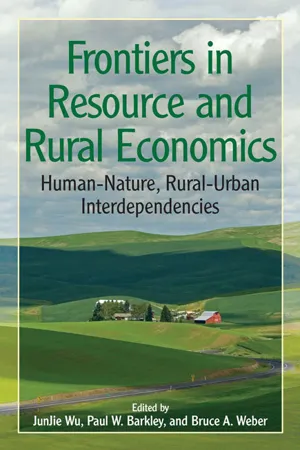Economics
Government Policies on Poverty
Government policies on poverty refer to the actions and measures implemented by a government to address and alleviate poverty within its population. These policies can include social welfare programs, minimum wage laws, education and healthcare initiatives, and tax policies aimed at redistributing wealth. The goal is to reduce poverty levels and improve the overall well-being of the population.
Written by Perlego with AI-assistance
Related key terms
9 Key excerpts on "Government Policies on Poverty"
- eBook - ePub
- (Author)
- 2011(Publication Date)
- Asian Development Bank(Publisher)
Environment and Urbanisation . 7 (1). April.2 . Timothy Besley and Robin Burgess. Can Labour Regulation Hinder Economic Performances? Evidence from India. London School of Economics.Passage contains an image
7 Government Initiatives for Poverty Eradication
F rom the beginning, poverty elimination has been a top priority with the Government of India. Several schemes and programs aimed at employment generation and social development have been implemented in the country. In general, the government’s anti-poverty strategy has had three broad components: promotion of economic growth, promotion of human development and targeted programs of poverty alleviation to address the multi-dimensional nature of poverty. As is recognized in the literature, in poor countries like India, almost all government policies can be thought of as being aimed at poverty reduction. These could be investments both in physical and social infrastructure, technology policies, regulatory policies, agricultural policies, fiscal policies, and the like. Apart from such broad-based programs, governments in countries where poverty is pervasive specifically design and implement policies that actively target the poor disproportionately more than the better-off. These typically consist of government expenditures on social sectors such as education, health, and policies specifically targeting rural development.Overview of Poverty-targeting Policies1The rationale underlying Poverty-targeting Policies (PTPs) is that the social returns from them are higher for the population at the lower end of income distribution than for those at the higher end. PTP initiatives have been ‘actively targeted’ at the poor through large public expenditure on social sectors and subsidies for economic services such as irrigation, fertilizers, food and power. For instance, the subsidies provided by the central and state governments in 1998–1999 accounted for around 13.5 percent of the GDP at market prices and 86 percent of the combined revenue receipts of the centre and states.2 Further, the central government expenditure on PTPs has grown both in nominal and real terms since the early 1990s although the growth rate in real terms has been less sharp (Table 7.1 ). Additionally, there has been a large proliferation of poverty alleviation programs implemented by the central government under the Centrally Sponsored Schemes (CSS); as of 2001, the number of CSS was 360. The Tenth Five Year Plan has recommended the rationalization of the large number of schemes through the elimination of 48 schemes, merging of 161 schemes into 53 and retaining the remaining 135 schemes. Detailed information on these large numbers of CSS is not always available as their design and implementation are spread across several ministries.3 - eBook - ePub
Public Policy in the United States
Challenges, Opportunities, and Changes
- Mark E Rushefsky, Mark E. Rushefsky(Authors)
- 2017(Publication Date)
- Routledge(Publisher)
Chapter 1 come into full play in poverty policy.This chapter begins by addressing the question of what poverty is and what its causes are. A statistical profile of those experiencing poverty is then presented. A portion of the chapter explores how the United States has responded to the problem over the years, focusing on fundamental changes in the nature of the poverty debate since 1969. Beginning in that year, the heart of the debate shifted from the problem of poverty and what to do about it to welfare as the problem and, in some eyes, the cause of the poverty problem. By 1995, that perspective, welfare as a cause of poverty, dominated the policy agenda.ANTIPOVERTY POLICY GOALS AND TOOLS
Policy Goals
A major goal of welfare policy is, in its broadest sense, security (Stone 2012). It is an attempt to provide—temporarily or permanently—a minimal level of assistance to those deemed worthy. Included in the category of “worthy” are the elderly (permanent assistance) and the young (temporary assistance). Another term used for this policy area is income security ; the federal government uses this category in its budget documents. If we employ this broader term, then Social Security would also be included, as we discuss later in this chapter.A second goal is to assist those capable of working to become fully supportive of themselves. Thus, some programs provide cash and in-kind (noncash) assistance, while others provide job training and educational assistance. A related goal of welfare policy is the desire to discourage dependence on the part of those who should be self-supporting. The tug of war between these two major goals (security/assistance and fostering independence) has affected the makeup of welfare policy over the years, with first one and then the other dominating. - eBook - ePub
- Andrew Barkley, Paul W. Barkley(Authors)
- 2020(Publication Date)
- Routledge(Publisher)
Chapter 11 Government policiesPhoto 11.1 Government policiesSource: M DOGAN/ShutterstockAbstract
Price policies, including price supports and price ceilings, are analyzed, with real-world examples highlighting the consequences of agricultural price policies in low-income and high-income nations. Welfare economics is used to understand how producer and consumer well-being changes in response to changes in policies, markets, and current events. Labor immigration is analyzed to find who gains and who loses from a nation accepting new workers into the workforce. Macroeconomics, the study of economy-wide features such as inflation and unemployment, is introduced. Monetary and fiscal policy are described, and their impacts on the agricultural sector detailed. Food security, hunger, global poverty, and economic development are outlined, and public goods are comprehensively explained.11.0 Introduction
Market economies have many advantages, including efficiency and a high standard of living. However, all real-world economies are mixed economies, with large and important roles for government programs and policies. Governments provide numerous important functions, even in the most free-market economy: the provision of law and order, public safety, national defense, education, research and development, health initiatives, and environmental protection, just to name a few.Economic programs include investments in infrastructure, research, and protection of some industries from foreign completion or market-based challenges. The government also conducts macroeconomic policies, which include fiscal and monetary policies intended to promote the functioning of the overall economy.Agriculture in the United States, and most nations, is characterized by heavy government intervention. Governments provide many programs and policies to ensure the provision of a sufficient, safe, and nutritious food supply. So far, this book has emphasized the benefits and advantages of markets: whatever goods that consumers desire are supplied by producers at the lowest possible cost. Competitive markets ensure that consumers have access to the goods and services that provide the greatest level of utility. Market-based economies, however, require government intervention due to “market failures,” or situations where markets provide undesirable outcomes. - eBook - ePub
An Atlas of Poverty in America
One Nation, Pulling Apart 1960–2003
- Amy Glasmeier(Author)
- 2014(Publication Date)
- Routledge(Publisher)
History of Poverty Policy
- 1930s–2004
Passage contains an image
American Poverty Policy from the 1930s to 2004
DOI: 10.4324/9781315786742-25From the 1930s to the 1950s
At the beginning of the 1960s, before the inauguration of the War on Poverty during the Johnson administration, federal programs to reduce poverty were based on social and economic issues that attended the national recovery from the Great Depression and the effects of World War II. Most, if not all, of the programs in place in the early 1960s were holdovers from the 1930s and 1940s.Poverty policy in the 1930s and 1940s had several goals. These included the reduction of unemployment and the provision of partial income replacement with Social Security and family assistance, with the ultimate goal being to ensure the existence of a modest and short-term safety net for the poor. In 1946 Congress passed the Employment Act to avoid the high unemployment rates found after World War II. The Act committed the government to maintaining high employment and high levels of purchasing power. Given the buoyant economy after the war, there was little need for federal intervention and the Act went unimplemented. Concern for the poor remained latent through much of the 1950s with the exception of the extension of certain preexisting benefits to a larger group in society, including children and the elderly. It was not until the late 1950s, when the U.S. economy began to flag and persistent geographic pockets of poverty reemerged, that poverty again became a highly visible issue to both politicians and the public.Early U.S. poverty policy sought to make the adjustments needed to ensure that all able-bodied persons with a job would be able to rise out of poverty and become contributing citizens of society. Existing poverty programs targeted the aged and certain family members such as women and children, but male workers were by and large excluded. This coverage, though well-intentioned and hard-fought, addressed only a small portion of the poverty problem. Lacking support were programs targeted toward individuals and families who worked but were still poor. In large sections of the nation, people worked but did not make a living wage (Levitan, 1973 ). In the South, mining and agriculture regions, and inner cities, work did not effectively pay (Douglas, 1971 - eBook - ePub
Food Policy for Developing Countries
The Role of Government in Global, National, and Local Food Systems
- Per Pinstrup-Andersen, Derrill D. Watson II(Authors)
- 2011(Publication Date)
- Cornell University Press(Publisher)
The primary purpose of this chapter is not to provide one grand explanation for poverty or one definitive solution to all poverty. It is rather to gain a greater appreciation for the complexity of what poverty is, what causes it, and how it interacts with the food system. After a discussion of the extent of income-poverty worldwide, we examine in more detail different aspects of the conceptualization of poverty, and discuss the measurement issues associated with the multidimensional definition of poverty.We conclude the chapter with a framework of policy intervention for poverty alleviation. Acknowledging the multidimensional nature of poverty, we propose that effective poverty reduction strategies should focus on three important areas: (1) promoting opportunity by expanding pro-poor economic growth and building up poor people’s assets while increasing the returns on these assets through a combination of market and nonmarket interventions, including agricultural research and infrastructure investment (chapter 7); (2) improving governance (chapter 9) by increasing participation of the poor—particularly marginalized groups—and government accountability; and (3) reducing risk through strategies such as safety nets, access to primary health care and education, and law enforcement that reduces the risk of crime (see also World Bank 2001c). We argue that, while making progress on all three fronts is important for poverty reduction, policy design should be context specific. We therefore avoid providing specific policy recommendations in this chapter.World Poverty Situation
Defining and Measuring Poverty
Poverty is a state where people do not have enough in some key dimensions of well-being. Most often, people think of poverty purely in monetary terms: the lack of money. A person is poor if his or her income, consumption, expenditure, or wealth falls below a certain threshold or poverty line. Poverty lines may be set either with reference to living standards (absolute poverty) or in comparison to a reference population (relative poverty). An example of a relative poverty line is the European Union poverty line, which is 60 percent of the median income. Considering that large parts of the populations of developing countries survive with the bare minimum, reliance on an absolute rather than a relative poverty line often proves to be more relevant. Unless otherwise stated, this chapter refers to absolute poverty. - eBook - ePub
- Anthony L Hall, James Midgley(Authors)
- 2004(Publication Date)
- SAGE Publications Ltd(Publisher)
2
POVERTY, INEQUALITY AND DEVELOPMENT: THE CHALLENGE FOR SOCIAL POLICY
Summary
This chapter is concerned with the problems of poverty and inequality and their relation to development. The chapter contends that social policies that directly address the poverty problem in the context of development are needed. The chapter is divided into four sections. The first section is concerned with the way poverty has been conceptualized and defined. It examines absolute and relative poverty lines and discusses the role of social indicators in understanding poverty. Attention is given to definitions of poverty that stress inequality and oppression and to behavioural definitions that employ the notion of social exclusion and the under-class. The section concludes with a discussion of recent debates attending the definition of poverty. The chapter’s second section examines income studies as well as studies of the quality of life to determine the extent of global poverty. An account of the incidence of poverty in different world regions is provided. This material is related to historical trends that show that, while the incidence of poverty has declined in some parts of the world, it remains a problem of huge and serious proportions for hundreds of millions of people. The final section deals with strategies for poverty eradication. It contends that poverty alleviation strategies are linked to wider values and beliefs. The section outlines several of these strategies from a historical perspective, showing that quite different approaches for poverty eradication have evolved over the last 50 years. These different strategic approaches are outlined and assessed. They are the modernization approach; the develop-mentalist state planning approach; the critical approach; the community participation and local development approach; and the neo-liberal approach. The chapter’s final section contends that the social development approach as articulated at the United Nations World Summit provides the most useful framework for dealing with the challenge of poverty and inequality today. - eBook - ePub
Social Policy in the United States
Future Possibilities in Historical Perspective
- Theda Skocpol(Author)
- 2020(Publication Date)
- Princeton University Press(Publisher)
CHAPTER EIGHT
Targeting within Universalism: Politically Viable Policies to Combat Poverty in the United States
WHAT TO DO about poverty is, once again, on the public agenda in the United States. Just a few years back, academics and research funders, whipsawed by backlashes against the War on Poverty and the Moynihan report, averted their attention from poverty and other race-related social ills. Then Charles Murray’s broadsides against federal social policies in Losing Ground provoked outraged critics to enter the fray again; and William Julius Wilson’s The Truly Disadvantaged revalidated discussion of “the underclass” by progressives as well as conservatives.1 Now analysts are looking closely and talking frankly about the full range of social problems and policy solutions connected to poverty, including severe inner-city black poverty.This new interest is good news for citizens who want to strengthen public efforts against poverty. But there are also reasons to worry, and not only because the overall tone of academic and political discourse is much less optimistic than in the 1960s. Recent debates have been imbued with presumptions of a national budget crisis, with cynicism about what government can do, and with extreme pessimism about the intractability of the problems of the inner-city poor. Thus those who want to do more to fight poverty are understandably concerned that their proposals may be stalled or perverted into purely disciplinary measures. Yet they also need to worry about how much the policy prescriptions they are debating recapitulate the flawed presumptions and tactics of the War on Poverty and the Great Society. If supporters of new social policies do find openings in the near future, they need to do better politically than did the antipoverty warriors of the 1960s and early 1970s, whose best intentions were not realized. It is not clear, however, that current debates about poverty and welfare are breaking enough new ground to make politically successful policy innovations likely. - eBook - ePub
- China Development Research Foundation(Author)
- 2019(Publication Date)
- Routledge(Publisher)
4 China's poverty alleviation policies Goals and impactsFast economic growth has been a decisive factor in the massive reduction of poverty in China. In addition, the Chinese Government has formulated and implemented poverty alleviation policies and measures targeting certain regions and groups of people, both in rural and urban areas. In recent years, other reforms, while targeted towards the entire rural population, have also contributed to poverty reduction through improvements related to agricultural taxation and subsidization, basic education, environmental protection, and medical and sanitary services.This chapter will describe the evolution, goals and impacts of poverty alleviation policies. An assessment of impacts chiefly looks at the degree of implementation in terms of target populations and whether or not policies have reached the poor. Where data permit, the degree of benefits for people in poverty is also analysed.Main Poverty Alleviation Policies and Their Characteristics
Table 4.1 sets out the major poverty alleviation policies for rural and urban areas that have had an important influence on the poor population. China implemented these in rural areas far earlier than in urban areas, so the policy course varies between the two. The focus in rural areas has been mainly on developmental poverty alleviation and in urban areas on social security.China's two-tier system for poverty alleviation: developmental poverty alleviation in rural areas and social security in urban areas
China's targeted poverty alleviation policies began in the mid 1980s in rural areas. Urban poverty did not receive much attention until the mid 1990s, when the reform of state-owned enterprises started and many employees were laid off. In China at that time, rural and urban areas were separated from each other by the residency registration management system, which had featured a - eBook - ePub
Frontiers in Resource and Rural Economics
Human-Nature, Rural-Urban Interdependencies
- Wu JunJie, Paul W Barkley, Bruce A Weber(Authors)
- 2010(Publication Date)
- Routledge(Publisher)
The current policy environment for poverty reduction emphasizes strategies that invest in people and provide incentives for people to work, and neglects strategies that attempt to improve the local context by investing in places. The important changes in social policy in the 1990s (the expansion of federal and state earned-income tax credits, welfare reform, minimum wage increase, and the expansion of Medicaid and child care subsidies) all focus on making the worker more productive and making work pay. Although there is some evidence that the social policy changes of the 1990s do not work as well in reducing poverty in rural areas (Weber et al. 2004), almost no attention has been paid to investing in place-specific infrastructure that would increase the demand for workers or to making investments in community institutions that could increase the effectiveness of policy.There are, however, at least three reasons why policies to improve local community context and institutions may be more important in poverty reduction now than in the past.First, state and local governments are playing a stronger role in social policy. In the 1996 welfare reform law, the federal government gave states much more discretion in lowering barriers to work (e.g., discretion to disregard higher income in calculating benefits) and increasing asset limits for eligibility (Gais and Weaver 2002). States have also taken initiative in increasing state earned-income tax credits. Local human service systems, furthermore, have streamlined program entry and worked to ensure continuity of coverage in food stamps and Medicaid for those leaving welfare (Fossett et al. 2002). The ability of localities to use this discretion in policy formulation and implementation makes a greater difference for poverty reduction than in the past.Second, nongovernmental (often locally based) organizations have been given new roles in delivery of welfare and workforce services. Nathan and Gais (1999) have noted the increased use of regional nonprofit organizations in providing melded welfare and workforce services. And welfare reform's charitable choice provisions gave added attention to the roles of faith-based organizations in the delivery of social services (Bartkowski and Regis 2002).Finally, and perhaps most importantly, antipoverty policy is increasingly work-related. The success of work-related policy depends to a greater extent on local opportunities and the effectiveness of local intermediaries and social networks. The 1996 redesign of the nation's major welfare program—creating the Temporary Assistance to Needy Families program—provided incentives for working and sanctions for not working (Moffitt 2003b). Most public spending on means-tested transfer programs (eligibility for which is conditioned on having low income) goes to in-kind medical and food security programs, work-related tax credits, and work-related support services (child care subsidies, job training), not cash welfare payments (Moffit 2003a, 7).7 Several studies have shown the importance of local context for the work outcomes of low-income adults8
Learn about this page
Index pages curate the most relevant extracts from our library of academic textbooks. They’ve been created using an in-house natural language model (NLM), each adding context and meaning to key research topics.
